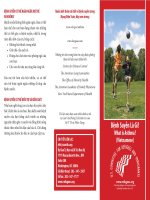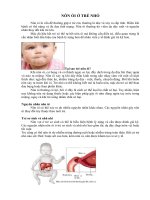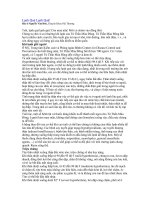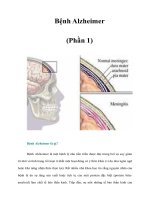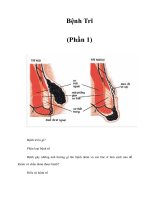Tài liệu Global Initative For Asthma doc
Bạn đang xem bản rút gọn của tài liệu. Xem và tải ngay bản đầy đủ của tài liệu tại đây (1.11 MB, 32 trang )
POCKET GUIDE FOR
ASTHMA MANAGEMENT
AND PREVENTION
A Pocket Guide for Physicians and Nurses
Updated 2011
(for Adults and Children Older than 5 Years
BASED ON THE GLOBAL STRATEGY FOR ASTHMA
MANAGEMENT AND PREVENTION
© Global Initiative for Asthma
COPYRIGHTED MATERIAL - DO NOT ALTER OR REPRODUCE
COPYRIGHTED MATERIAL - DO NOT ALTER OR REPRODUCE
GLOBAL INITIATIVE
FOR ASTHMA
Board of Directors (2011)
Eric D. Bateman, M.D., South Africa, Chair
Louis-Philippe Boulet, M.D., Canada
Alvaro Cruz, M.D., Brazil
Mark FitzGerald, M.D., Canada
Tari Haahtela, M.D., Finland
Mark Levy, M.D., United Kingdom
Paul O’Byrne, M.D., Canada
Ken Ohta, M.D., Japan
Pierluigi Paggario, M.D., Italy
Soren Pedersen, M.D., Denmark
Manuel Soto-Quiroz, M.D., Costa Rica
Gary Wong, M.D., Hong Kong ROC
GINA Assembly (2011)
Louis-Philippe Boulet, MD, Canada, Chair
GINA Assembly members from 45
countries (names are listed on website:
www.ginasthma.org)
®
®
© Global Initiative for Asthma
COPYRIGHTED MATERIAL - DO NOT ALTER OR REPRODUCE
TABLE OF CONTENTS
PREFACE 3
WHAT IS KNOWN ABOUT ASTHMA?
5
DIAGNOSING ASTHMA
7
Figure 1. Is it Asthma? 7
CLASSIFICATION OF ASTHMA BY LEVEL OF CONTROL
9
Figure 2. Levels of Asthma Control 9
FOUR COMPONENTS OF ASTHMA CARE 10
Component 1. Develop Patient/Doctor Partnership 10
Figure 3. Example of Contents of an Action Plan to Maintain
Asthma Control 11
Component 2. Identify and Reduce Exposure to Risk Factors 12
Figure 4. Strategies for Avoiding Common Allergens and
Pollutants 12
Component 3. Assess, Treat, and Monitor Asthma 13
Figure 5. Management Approach Based on Control 15
Figure 6. Estimated Equipotent Doses of Inhaled
Glucocorticosteroids 16
Figure 7. Questions for Monitoring Asthma care 18
Component 4. Manage Exacerbations 19
Figure 8. Severity of Asthma Exacerbations 22
SPECIAL CONSIDERATIONS IN MANAGING ASTHMA 23
Appendix A: Glossary of Asthma Medications - Controllers 24
Appendix B: Combination Medications for Asthma 25
Appendix C: Glossary of Asthma Medications - Relievers 26
COPYRIGHTED MATERIAL - DO NOT ALTER OR REPRODUCE
3
PREFACE
Asthma is a major cause of chronic morbidity and mortality throughout the
world and there is evidence that its prevalence has increased considerably
over the past 20 years, especially in children. The Global Initiative for
Asthma was created to increase awareness of asthma among health
professionals, public health authorities, and the general public, and to
improve prevention and management through a concerted worldwide
effort. The Initiative prepares scientific reports on asthma, encourages
dissemination and implementation of the recommendations, and promotes
international collaboration on asthma research.
The Global Initiative for Asthma offers a framework to achieve and maintain
asthma control for most patients that can be adapted to local health care
systems and resources. Educational tools, such as laminated cards, or
computer-based learning programs can be prepared that are tailored to
these systems and resources.
The Global Initiative for Asthma program publications include:
• Global Strategy for Asthma Management and Prevention (2011).
Scientific information and recommendations for asthma programs.
• Global Strategy for Asthma Management and Prevention
GINA Executive Summary. Eur Respir J 2008; 31: 1-36
• Pocket Guide for Asthma Management and Prevention for Adults
and Children Older Than 5 Years (2011). Summary of patient care
information for primary health care professionals.
• Pocket Guide for Asthma Management and Prevention in Children 5
Years and Younger (2009). Summary of patient care information for
pediatricians and other health care professionals.
• What You and Your Family Can Do About Asthma. An information
booklet for patients and their families.
Publications are available from www.ginasthma.org.
This Pocket Guide has been developed from the Global Strategy for Asthma
Management and Prevention (Updated 2011). Technical discussions of
asthma, evidence levels, and specific citations from the scientific literature
are included in that source document.
COPYRIGHTED MATERIAL - DO NOT ALTER OR REPRODUCE
4
Acknowledgements:
Grateful acknowledgement is given for unrestricted educational grants
from Almirall, AstraZeneca, Boehringer Ingelheim, Chiesi Group, CIPLA,
GlaxoSmithKline, Merck Sharp & Dohme, Novartis, Nycomed and
Pharmaxis. The generous contributions of these companies assured that the
GINA Committees could meet together and publications could be printed
for wide distribution. However, the GINA Committee participants are solely
responsible for the statements and conclusions in the publications.
COPYRIGHTED MATERIAL - DO NOT ALTER OR REPRODUCE
5
WHAT IS KNOWN
ABOUT ASTHMA?
Unfortunately…asthma is one of the most common chronic diseases, with
an estimated 300 million individuals affected worldwide. Its prevalence is
increasing, especially among children.
Fortunately…asthma can be effectively treated and most patients can
achieve good control of their disease. When asthma is under control
patients can:
√ Avoid troublesome symptoms night and day
√ Use little or no reliever medication
√ Have productive, physically active lives
√ Have (near) normal lung function
√ Avoid serious attacks
• Asthma causes recurring episodes of wheezing, breathlessness, chest
tightness, and coughing, particularly at night or in the early morning.
• Asthma is a chronic inflammatory disorder of the airways. Chronically
inflamed airways are hyperresponsive; they become obstructed and
airflow is limited (by bronchoconstriction, mucus plugs, and increased
inflammation) when airways are exposed to various risk factors.
• Common risk factors for asthma symptoms include exposure to allergens
(such as those from house dust mites, animals with fur, cockroaches,
pollens, and molds), occupational irritants, tobacco smoke, respiratory
(viral) infections, exercise, strong emotional expressions, chemical
irritants, and drugs (such as aspirin and beta blockers).
• A stepwise approach to pharmacologic treatment to achieve and
maintain control of asthma should take into account the safety of
treatment, potential for adverse effects, and the cost of treatment
required to achieve control.
• Asthma attacks (or exacerbations) are episodic, but airway inflammation
is chronically present.
COPYRIGHTED MATERIAL - DO NOT ALTER OR REPRODUCE
6
• For many patients, controller medication must be taken daily to prevent
symptoms, improve lung function, and prevent attacks. Reliever
medications may occasionally be required to treat acute symptoms such
as wheezing, chest tightness, and cough.
• To reach and maintain asthma control requires the development of a
partnership between the person with asthma and his or her health care
team.
• Asthma is not a cause for shame. Olympic athletes, famous leaders,
other celebrities, and ordinary people live successful lives with asthma.
COPYRIGHTED MATERIAL - DO NOT ALTER OR REPRODUCE
7
DIAGNOSING ASTHMA
Asthma can often be diagnosed on the basis of a patient’s symptoms and
medical history (Figure 1).
Measurements of lung function provide an assessment of the severity,
repairability, and variability of airflow limitation, and help confirm the
diagnosis of asthma.
Spirometry is the preferred method of measuring airflow limitation and its
reversibility to establish a diagnosis of asthma.
• An increase in FEV
1
of ≥ 12% and ≥ 200 ml after administration
of a bronchodilator indicates reversible airflow limitation consistent
with asthma. (However, most asthma patients will not exhibit reversibility
at each assessment, and repeated testing is advised.)
Presence of any of these signs and symptoms should increase the suspicion of asthma:
Wheezing high-pitched whistling sounds when breathing out—especially
in children. (A normal chest examination does not exclude asthma.)
History of any of the following:
• Cough, worse particularly at night
• Recurrent wheeze
• Recurrent difficult breathing
• Recurrent chest tightness
Symptoms occur or worsen at night, awakening the patient.
Symptoms occur or worsen in a seasonal pattern.
The patient also has eczema, hay fever, or a family history
of asthma or atopic diseases.
Symptoms occur or worsen in the presence of:
• Animals with fur
• Aerosol chemicals
• Changes in temperature
• Domestic dust mites
• Drugs (aspirin, beta blockers)
• Exercise
• Pollen
• Respiratory (viral) infections
• Smoke
• Strong emotional expression
Symptoms respond to ant-asthma therapy
Patients colds "go to the chest" or take more than 10 days to clear up
Figure 1. Is it Asthma?
COPYRIGHTED MATERIAL - DO NOT ALTER OR REPRODUCE
8
Peak expiratory flow (PEF) measurements can be an important aid in both
diagnosis and monitoring of asthma.
• PEF measurements are ideally compared to the patient’s own previous
best measurements using his/her own peak flow meter.
• An improvement of 60 L/min (or≥ 20% of the pre-bronchodilator PEF)
after inhalation of a bronchodilator, or diurnal variation in PEF of
more than 20% (with twice-daily readings, more than 10%), suggests
a diagnosis of asthma.
Additional diagnostic tests:
• For patients with symptoms consistent with asthma, but normal lung
function, measurements of airway responsiveness to methacholine
and histamine, an indirect challenge test such as inhaled mannitol, or
exercise challenge may help establish a diagnosis of asthma.
• Skin tests with allergens or measurement of specific IgE in serum:
The presence of allergies increases the probability of a diagnosis
of asthma, and can help to identify risk factors that cause asthma
symptoms in individual patients.
Diagnostic Challenges
Cough-variant asthma. Some patients with asthma have chronic cough
(frequently occurring at night) as their principal, if not only, symptom.
For these patients, documentation of lung function variability and
airway hyperresponsiveness are particularly important.
Exercise-induced bronchoconstriction. Physical activity is an important
cause of asthma symptoms for most asthma patients, and for some
(including many children) it is the only cause. Exercise testing with an
8-minute running protocol can establish a firm diagnosis of asthma.
Children 5 Years and Younger. Not all young children who wheeze
have asthma. In this age group, the diagnosis of asthma must be based
largely on clinical judgment, and should be periodically reviewed as
the child grows (see the GINA Pocket Guide for Asthma Management
and Prevention in Children 5 Years and Younger for further details).
Asthma in the elderly. Diagnosis and treatment of asthma in the elderly
are complicated by several factors, including poor perception of
symptoms, acceptance of dyspnea as being “normal” for old age, and
reduced expectations of mobility and activity. Distinguishing asthma
from COPD is particularly difficult, and may require a trial of treatment.
Occupational asthma. Asthma acquired in the workplace is a
diagnosis that is frequently missed. The diagnosis requires a defined
history of occupational exposure to sensitizing agents; an absence of
asthma symptoms before beginning employment; and a documented
relation¬ship between symptoms and the workplace (improvement in
symptoms away from work and worsening of symptoms upon returning
to work).
COPYRIGHTED MATERIAL - DO NOT ALTER OR REPRODUCE
9
CLASSIFICATION OF ASTHMA
BY LEVEL OF CONTROL
The goal of asthma care is to achieve and maintain control of the clinical
manifestations of the disease for prolonged periods. When asthma is
controlled, patients can prevent most attacks, avoid troublesome symptoms
day and night, and keep physically active.
The assessment of asthma control should include control of the clinical
manifestations and control of the expected future risk to the patient such
as exacerbations, accelerated decline in lung function, and side-effects of
treatment. In general, the achievement of good clinical control of asthma
leads to reduced risk of exacerbations.
Figure 2 describes the clinical characteristics of controlled, partly controlled,
and uncontrolled asthma.
Examples of validated measures for assessing clinical control of asthma include:
• Asthma Control Test (ACT): www.asthmacontrol.com
• Childhood Asthma Control test (C-Act)
• Asthma Control Questionnaire (ACQ): www.qoltech.co.uk/Asthma1.htm
• Asthma Therapy Assessment Questionnaire (ATAQ): www.ataqinstrument.com
• Asthma Control Scoring System
Figure 2. Levels of Asthma Control
A. Assessment of current clinical control (preferably over 4 weeks)
Characteristics Controlled
(All of the following)
Partly Controlled
(Any measure presented)
Uncontrolled
Daytime symptoms None (twice or less/week) More than twice/week Three or more features of
partly controlled asthma*†
Limitation of activities None Any
Nocturnal
symptoms/awaking
None Any
Need for reliever/
rescue inhaler
None (twice or less/week) More than twice/week
Lung function (PEF or FEV
1
)‡ Normal < 80% predicted or
personal best (if known)
B. Assessment of Future Risk (risk of exacerbations, instability, rapid decline in lung function, side effects)
Features that are associated with increased risk of adverse events in the future include:
Poor clinical control, frequent exacerbations in past year*, ever admission to critical care for asthma, low FEV
1
, exposure to
cigarette smoke, high dose medications
* Any exacerbation should prompt review of maintenance treatment to ensure that it is adequate
† By definition, an exacerbation in any week makes that an uncontrolled asthma week
‡ Without administration of bronchodilator, lung function is not a reliable test for children 5 years and younger.
COPYRIGHTED MATERIAL - DO NOT ALTER OR REPRODUCE
10
FOUR COMPONENTS OF
ASTHMA CARE
Four interrelated components of therapy are required to achieve and maintain
control of asthma:
Component 1. Develop patient/doctor partnership
Component 2. Identify and reduce exposure to risk factors
Component 3. Assess, treat, and monitor asthma
Component 4. Manage asthma exacerbations
Component 1: Develop Patient/Doctor Partnership
The effective management of asthma requires the development of a partnership
between the person with asthma and his or her health care team.
With your help, and the help of others on the health care team, patients can
learn to:
• Avoid risk factors
• Take medications correctly
• Understand the difference between "controller" and "reliever" medications
• Monitor their status using symptoms and, if relevant, PEF
• Recognize signs that asthma is worsening and take action
• Seek medical advice as appropriate
Education should be an integral part of all interactions between health care
professionals and patients. Using a variety of methods—such as discussions
(with a physician, nurse, outreach worker, counselor, or educator),
demonstrations, written materials, group classes, video or audio tapes,
dramas, and patient support groups—helps reinforce educational messages.
Working together, you and your patient should prepare a written personal
asthma action plan that is medically appropriate and practical. A sample
asthma plan is shown in Figure 3.
Additional written asthma action plans can be found on several websites,
including:
www.asthma.org.uk
www.nhlbisupport.com/asthma/index.html
www.asthmanz.co.nz
COPYRIGHTED MATERIAL - DO NOT ALTER OR REPRODUCE
11
Figure 3. Example of Contents of a Written Asthma to Maintain Asthma Control
Your Regular Treatment:
1.Each day take__________________________
2.Before exercise, take___________________
WHEN TO INCREASE TREATMENT
Assess your level of Asthma Control
In the past week have you had:
Daytime asthma symptoms more than 2 times? No Yes
Activity or exercise limited by asthma? No Yes
Walking at night because of asthma? No Yes
The need to use your (rescue medication) more than 2 times? No Yes
If you are monitoring peak flow, peak flow less than______? No Yes
If you answered YES to three or more of these questions, your asthma is uncontrolled
and you may need to step up your treatment.
HOW TO INCREASE TREATMENT
STEP UP your treatment as follows and assess improvement every day:
_________________________________[Write in next treatment step here]
Maintain this treatment for_______________________days [specify number]
WHEN TO CALL THE DOCTOR/CLINIC.
Call your doctor/clinic: ________________________ [provide phone numbers]
If you don't respond in ________________ days [specify number]
___________________________________ [optional lines for additional
instruction]
EMERGENCY/SEVERE LOSS OF CONTROL
√ If you have severe shortness of breath, and can only speak in short sentences,
√ If you having a severe attack of asthma and are frightened,
√ If you need your reliever medication more than every 4 hours and are not
improving.
1. Take 2 to 4 puffs ___________________ [reliever medication].
2. Use ______ mg of __________________________(oral glucocorticosteriod).
3. Seek medical help: Go to _______________________________
______________Address:________________________Phone:
__________________________
4. Continue to use your __________________________________[reliever
medication] until your are able to get medical help.
COPYRIGHTED MATERIAL - DO NOT ALTER OR REPRODUCE
12
Component 2: Identify and Reduce Exposure to Risk Factors
To improve control of asthma and reduce medication needs, patients should
take steps to avoid the risk factors that cause their asthma symptoms (Figure
4). However, many asthma patients react to multiple factors that are ubiquitous
in the environment, and avoiding some of these factors completely is nearly
impossible. Thus, medications to maintain asthma control have an important
role because patients are often less sensitive to these risk factors when their
asthma is under control.
Physical activity is a common cause of asthma symptoms but patients should not
avoid exercise. Symptoms can be prevented by taking a rapid-acting inhaled
β
2
-agonist before strenuous exercise (a leukotriene modifier or cromone are
alternatives).
Patients with moderate to severe asthma should be advised to receive an
influenza vaccination every year, or at least when vaccination of the general
population is advised. Inactivated influenza vaccines are safe for adults and
children over age 3.
Avoidance measures that improve control of asthma and reduce medication needs:
• Tobacco smoke: Stay away from tobacco smoke. Patients and parents should not smoke.
• Drugs, foods, and additives: Avoid if they are known to case symptoms.
• Occupational sensitizers: Reduce or, preferably, avoid exposure to these agents
Reasonable avoidance measures that can be recommended but have not been shown to have clinical benefit
• House dust mites: Wash bed linens and blankets weekly in hot water and dry in a hot
dryer or sun. Encase pillows and mattresses in air-tight covers. Replace carpets with hard
flooring, especially in sleeping rooms. (If possible, use vacuum cleaner with filters. Use
acaricides or tannic acid to kill mites but make sure the patient is not at home when the
treatment occurs.
• Animals with fur: Use air filters. (Remove animals from the home, or at least from the
sleeping area. Wash the pet.)
• Cockroaches: Clean home thoroughly and often. Use pesticide spray but make sure
the patient is not at home when spraying occurs.
• Outdoor pollens and mold: Close windows and doors and remain indoors when
pollen and mold counts are highest.
• Indoor mold: Reduce dampness in the home; clean any damp areas frequently
Figure 4. Strategies for Avoiding Common Allergens and Pollutants
COPYRIGHTED MATERIAL - DO NOT ALTER OR REPRODUCE
13
Component 3: Assess, Treat and Monitor Asthma
The goal of asthma treatment—to achieve and maintain clinical control—
can be reached in most patients through a continuous cycle that involves
• Assessing Asthma Control
• Treating to Achieve Control
• Monitoring to Maintain Control
Assessing Asthma Control
Each patient should be assessed to establish his or her current treatment
regimen, adherence to the current regimen, and level of asthma control.
A simplified scheme for recognizing controlled, partly controlled, and
uncontrolled asthma is provided in Figure 2.
Treating to Achieve Control
Each patient is assigned to one of five treatment “steps.” Figure 5 details the
treatments at each step for adults and children age 5 and over.
At each treatment step, reliever medication should be provided for quick
relief of symptoms as needed. (However, be aware of how much reliever
medication the patient is using—regular or increased use indicates that
asthma is not well controlled.)
At Steps 2 through 5, patients also require one or more regular controller
medications, which keep symptoms and attacks from starting. Inhaled
glucocorticosteroids (Figure 6) are the most effective controller medications
currently available.
For most patients newly diagnosed with asthma or not yet on medication,
treatment should be started at Step 2 (or if the patient is very symptomatic,
at Step 3). If asthma is not controlled on the current treatment regimen,
treatment should be stepped up until control is achieved.
Patients who do not reach an acceptable level of control at Step 4 can be
considered to have difficult-to-treat asthma. In these patients, a compromise
may need to be reached focusing on achieving the best level of control
feasible—with as little disruption of activities and as few daily symptoms as
possible—while minimizing the potential for adverse effects from treatment.
Referral to an asthma specialist may be helpful.
COPYRIGHTED MATERIAL - DO NOT ALTER OR REPRODUCE
14
A variety of controller (Appendix A and Appendix B) and reliever (Appendix
C) medications for asthma are available. The recommended treatments are
guidelines only. Local resources and individual patient circumstances should
determine the specific therapy prescribed for each patient.
Inhaled medications are preferred because they deliver drugs directly to the
airways where they are needed, resulting in potent therapeutic effects with
fewer systemic side effects. Inhaled medications for asthma are available
as pressurized metered-dose inhalers (pMDIs), breath-actuated MDIs, dry
powder inhalers (DPIs), and nebulizers. Spacer (or valved holding-chamber)
devices make inhalers easier to use and reduce systemic absorption and
side effects of inhaled glucocorticosteroids.
Teach patients (and parents) how to use inhaler devices. Different devices
need different inhalation techniques.
• Give demonstrations and illustrated instructions.
• Ask patients to show their technique at every visit.
• Information about use of various inhaler devices is found on the
GINA Website (www.ginasthma.org).
COPYRIGHTED MATERIAL - DO NOT ALTER OR REPRODUCE
15
Figure 5. Management Approach Based on Control Adults and Children Older Than 5 Years
Controller
options***
Treatment Steps
As needed rapid-
acting β
2
-agonist
As needed rapid-acting β
2
-agonist
Low-dose ICS plus
long-acting β
2
-agonist
Select one
Leukotriene
modifier**
Select one
Medium-or
high-dose ICS
Medium-or high-dose
ICS plus long-acting
β
2
-agonist
Low-dose ICS plus
leukotriene modifier
Low-dose ICS plus
sustained release
theophylline
To Step 3 treatment,
select one or more
To Step 4 treatment,
add either
Asthma education. Environmental control.
(If step-up treatment is being considered for poor symptom control, first check inhaler technique, check adherence, and confirm symptoms are due to asthma.)
Low-dose inhaled
ICS
*
Oral glucocorticosteroid
(lowest dose)
Anti-IgE
treatment
Leukotriene
modifier
Sustained release
theophylline
Controlled Maintain and find lowest controlling step
Partly controlled Consider stepping up to gain control
Uncontrolled
Step up until controlled
Exacerbation
Treat as exacerbation
Treatment ActionLevel of Control
Reduce
Reduce Increase
Increase
2
Step
1
Step
3
Step
4
Step
5
Step
*ICS = inhaled glucocorticosteroids
**=Receptor antagonist or synthesis inhibitors
***=Recommneded treatment (shaded boxes) based on group mean data. Individual patient needs, preferences, and cirumstances
(including costs) should be considered.
Alternative reliever treatments include inhaled anticholinergics, short-acting oral β2-agonists, some long-acting β
2
-agonists, and short-acting theophylline.
Regular dosing with short and long-acting β2-agonists is not advised unless accompanied by regular use of an inhaled glucocorticorsteriod.
For management of asthma in children 5 years and younger, refer to the Global Strategy for the Diagnosis and Management
of Asthma in Children 5 Years and Younger, available at .
COPYRIGHTED MATERIAL - DO NOT ALTER OR REPRODUCE
16
Figure 6. Estimated Equipotent Daily Doses of Inhaled
Glucocorticosteroids for Adults and Children Older than 5 Years †
Drug Low Dose (µg)†
Medium Daily Dose
(µg)†
High Daily Dose (µg)†
Beclomethasone
dipropionate - CFC
200 - 500 > 500 - 1000 > 1000 - 2000
Beclomethasone
dipropionate - HFA
100 - 250 > 250 - 500 > 500 - 1000
Budesonide* 200 - 400 > 400 - 800 > 800 - 1600
Ciclesonide* 80 - 160 > 160 - 320 > 320 - 1280
Flunisolide 500 - 1000 > 1000 - 2000 >2000
Fluticasone propionate 100 - 250 > 250 - 500 >500 - 1000
Mometasone furoate* 200 >400 >800
Triamcinolone
acetonide
400 - 1000 >1000 - 2000 >2000
† Comparisons based on efficacy data.
‡ Patients considered for high daily doses except for short periods should be referred to a specialist for assessment to
consider alternative combinations of controllers. Maximum recommended doses are arbitrary but with prolonged use are
associated with increased risk of systemic side effects.
* Approved for once-daily dosing in mild patients.
Notes
• The most important determinant of appropriate dosing is the clinician's judgment of the patient's response
to therapy. The clinician must monitor the patient's response in terms of clinical control and adjust the dose
accordingly. Once control of asthma is achieved, the dose of medication should be carefully titrated to the
minimum dose required to maintain control, thus reducing the potential for adverse effects.
• Designation of low, medium, and high doses is provided from manufacturers' recommendations where possible.
Clear demonstration of dose response relationships is seldom provided or available. The principle is therefore to
establish the minimum effective controlling dose in each patient, as higher doses may not be more effective and
are likely to be associated with greater potential for adverse effects.
• As CFC preparations are taken from the market, medication inserts for HFA preparations should be carefully
reviewed by the clinician for the equivalent correct dosage.
COPYRIGHTED MATERIAL - DO NOT ALTER OR REPRODUCE
17
Monitoring to Maintain Control
Ongoing monitoring is essential to maintain control and establish the lowest
step and dose of treatment to minimize cost and maximize safety.
Typically, patients should be seen one to three months after the initial visit,
and every three months thereafter. After an exacerbation, follow-up should be
offered within two weeks to one month.
At each visit, ask the questions listed in Figure 7.
Adjusting medication:
• If asthma is not controlled on the current treatment regimen, step up
treatment. Generally, improvement should be seen within 1 month.
But first review the patient’s medication technique, compliance, and
avoidance of risk factors.
• If asthma is partly controlled, consider stepping up treatment, depending
on whether more effective options are available, safety and cost of
possible treatment options, and the patient’s satisfaction with the level
of control achieved.
• If control is maintained for at least 3 months, step down with a gradual,
stepwise reduction in treatment. The goal is to decrease treatment to the
least medication necessary to maintain control.
Monitoring is still necessary even after control is achieved, as asthma is a
variable disease; treatment has to be adjusted periodically in response to
loss of control as indicated by worsening symptoms or the development of an
exacerbation.
COPYRIGHTED MATERIAL - DO NOT ALTER OR REPRODUCE
18
Figure 7. Questions for Monitoring Asthma Care
IS THE ASTHMA MANAGEMENT PLAN MEETING EXPECTED GOALS
Ask the patient:
Has your asthma awakened you at night?
Have you needed more reliever medications than usual?
Have you needed any urgent medical are?
Has your peak flow been below your personal best?
Are you participating in your usual physical activities?
Action to consider:
Adjust medications and management plan as needed
(step up or down).
But first, compliance should be assessed.
IS THE PATIENT USING INHALERS, SPACER, OR PEAK FLOW METERS CORRECTLY?
Ask the patient:
Please show me how you take your medicine.
Action to consider:
Demonstrate correct technique.
Have patient demonstrate back.
IS THE PATIENT TAKING THE MEDICATIONS AND AVOIDING RISK
FACTORS ACCORDING TO THE ASTHMA MANAGEMENT PLAN?
Ask the patient, for example:
So that we may plan therapy, please tell me how
often you actually take the medicine.
What problems have you had following the
management plan or taking your medicine?
During the last month, have you ever stopped taking
your medicine because you were feeling better?
Action to consider:
Adjust plan to be more practical.
Problem solve with the patient to overcome barriers to
following the plan.
DOES THE PATIENT HAVE ANY CONCERNS?
Ask the Patient:
What concerns might you have about your asthma,
medicines, or management plan?
Action to consider:
Provide additional education to relieve concerns and
discussion to overcome barriers.
COPYRIGHTED MATERIAL - DO NOT ALTER OR REPRODUCE
19
Component 4: Manage Exacerbations
Exacerbations of asthma (asthma attacks) are episodes of a progressive increase
in shortness of breath, cough, wheezing, or chest tightness, or a combination
of these symptoms.
Do not underestimate the severity of an attack; severe asthma attacks may be life
threatening. Their treatment requires close supervision.
Patients at high risk of asthma-related death require closer attention and should
be encouraged to seek urgent care early in the course of their exacerbations.
These patients include those:
• With a history of near-fatal asthma requiring intubation and mechanical
ventilation
• Who have had a hospitalization or emergency visit for asthma within
the past year
• Who are currently using or have recently stopped using oral
glucocorticosteroids
• Who are not currently using inhaled glucocorticosteroids
• Who are over dependent on rapid-acting β
2
-agnoists, especially those
who use more than one canister of salbutamol (or equivalent) monthly
• With a history of psychiatric disease or psychosocial problems,
including the use of sedatives
• With a history of noncompliance with an asthma medication plan
Patients should immediately seek medical care if:
• The attack is severe (Figure 8):
- The patient is breathless at rest, is hunched forward, talks in words
rather than sentences (infant stops feeding), is agitated, drowsy, or
confused, has bradycardia, or has a respiratory rate greater than 30
per minute
- Wheeze is loud or absent
- -Pulse is greater than 120/min (greater than160/min for infants)
- PEF is less than 60 percent of predicted or personal best, even after
initial treatment
- The patient is exhausted
• The response to the initial bronchodilator treatment is not prompt and
sustained for at least 3 hours
• There is no improvement within 2 to 6 hours after oral glucocorticosteroid
treatment is started
• There is further deterioration
COPYRIGHTED MATERIAL - DO NOT ALTER OR REPRODUCE
20
Mild attacks, defined by a reduction in peak flow of less than 20%, nocturnal
awakening, and increased us of rapid-acting β
2
-agonists, can usually be treated
at home if the patient is prepared and has a personal asthma management
plan that includes action steps.
Moderate attacks may require, and severe attacks usually require, care in a
clinic or hospital.
Asthma attacks require prompt treatment:
• Inhaled rapid-acting β
2
-agonists in adequate does are essential.
(Begin with 2 to 4 puffs every 20 minutes for the first hour; then mild
exacerbations will require 2 to 4 puffs every 3 to 4 hours, and moderate
exacerbations 6 to 10 puffs every 1 to 2 hours.)
• Oral glucocorticosteroids (0.5 to 1 mg of prednisolone/kg or equivalent
during a 24-hour period) introduced early in the course of a moderate or
severe attack help to reverse the inflammation and speed recovery.
• Oxygen is given at health centers or hospitals if the patient is hyopxemic
(achieve O
2
saturation of 95%)
• Combination β
2
-agonists/anticholinergic therapy is associated with
lower hospitalization rates and greater improvement in PEF and FEV
1
.
• Methylxanthines are not recommended if used in addition to high
doses of inhaled β
2
-agonists. However, theophylline can be used if
inhaled β
2
-agonists are not available. If the patient is already taking
theophylline on a daily basis, serum concentration should be measured
before adding short-acting theophylline.
• Patients with severe asthma exacerbations unresponsive to bronchodilators
and systemic glucocorticosteroids, 2 grams of magnesium sulphate IV has
been shown to reduce the need to hospitalizations.
Therapies not recommended for treating asthma attacks include:
• Sedatives (strictly avoid)
• Mucolytic drugs (may worsen cough)
• Chest physical therapy/physiotherapy (may increase patient discomfort)
• Hydration with large volumes of fluid for adults and older children (may be
necessary for younger children and infants)
• Antibiotics (do not treat attacks but are indicated for patients who also
have pneumonia or bacterial infection such as sinusitis)
• Epinephrine/adrenaline (may be indicated for acute treatment of
anaphylaxis and angioedema but is not indicated for asthma attacks)
COPYRIGHTED MATERIAL - DO NOT ALTER OR REPRODUCE
21
Monitor response to treatment:
Evaluate symptoms and, as much as possible, peak flow. In the hospital, also
assess oxygen saturation; consider arterial blood gas measurement in patients
with suspected hypoventilation, exhaustion, severe distress, or peak flow 30-50
percent predicted.
Follow up:
After the exacerbation is resolved, the factors that precipitated the exacerbation
should be identified and strategies for their future avoidance implemented, and
the patient’s medication plan reviewed.
COPYRIGHTED MATERIAL - DO NOT ALTER OR REPRODUCE
22
Figure 8. Severity of Asthma Exacerbations*
Parameter Mild Moderate Severe Respiratory
arrest imminent
Breathless Walking
Can lie down
Talking
Infant - softer, shorter cry;
difficulty feeding
Preferr sitting
At rest
Infant stops feeding
Hunched forward
Talks in Sentences Phrases Words
Alertness May be agitated Usually agitated Usually agitated Drowsy or confused
Respiratory rate Increased Increased Often > 30/min
Normal rates of breathing in awake children:
Age Normal rate
< 2 months <60/min
2 -12 months <50 /min
1- 5 years <40/min
6 - 8 years < 30/min
Accessory muscles
andsuprasternal
retractions
Usually not Usually Usually Paradoxical
thoraco-abdominal
movement
Wheeze Moderate, often only
and expiratory
Loud Usually loud Absence of wheeze
Pulse/min. <100 100 - 200 >120 Bradycardia
Guide to limits of normal pulse rate in children:
Infants 2 - 12 months - Normal rate< 160/min
Preschool 1 - 2 years - Normal rate <120/mi
School age 2 - 8 years - Normal rate < 110/min
Pulsus paradoxus Absent < 10 mm Hg May be present
10 - 25 mm Hg
Often present
> 25 mm Hg (adult)
20 - 40 mm Hg (childe)
Absence suggests
respiratory muscle
fatique
PEF after initial
bronchodilator
% predicted or
% personal best
Over 80% Approx. 60-80% < 60% predicted or
personal best
(< 100 L/min adults)
or response lasts < 2 hrs
PaO
2
(on air)
†
and/or
paCO
2
†
Normal
Test not usually
necessary
< 45 mm Hg
> 60 mm Hg
< 45 mm Hg
< 60 mm Hg
Possible cyanosis
> 45 mm Hg;
Possible respiratory
failure (see text)
SaO
2
% (on air)
†
>95% 91 - 95% <90%
Hypercapnia (hyperventilation) develops more readily in young children than adults and adolescents
*Note: The presence of several parameters, but no necessarily all, indicates the general classification of the exacerbation.
†Note: Kilopascals are also used internationally, conversion would be appropriate in this regard.
<60/min
<50 /min
<40/min
< 30/min
< 2 months
2 -12 months
1- 5 years
6 - 8 years
Infants
Preschool
School age
2 - 12 months
1 - 2 years
2 - 8 years
- Normal rate< 160/min
- Normal rate<120/min
- Normal rate< 110/min
COPYRIGHTED MATERIAL - DO NOT ALTER OR REPRODUCE
23
SPECIAL CONSIDERATIONS
IN MANAGING ASTHMA
Pregnancy During pregnancy the severity of asthma often changes, and patients
may require close follow-up and adjustment of medications. Pregnant patients
with asthma should be advised that the greater risk to their baby lies with poorly
controlled asthma, and the safety of most modern asthma treatments should be
stressed. Acute exacerbations should be treated aggressively to avoid fetal hypoxia.
Obesity. Management of asthma in the obese should be the same as patients with
normal weight. Weight loss in the obese patient improves asthma control, lung
function and reduces medication needs.
Surgery. Airway hyperresponsiveness, airflow limitation, and mucus hyper-secretion
predispose patients with asthma to intraoperative and postoperative respiratory
complications, particularly with thoracic and upper abdominal surgeries. Lung
function should be evaluated several days prior to surgery, and a brief course of
glucocorticosteroids prescribed if FEV
1
is less than 80% of the patient’s personal
best.
Rhinitis, Sinusitis, and Nasal Polyps. Rhinitis and asthma often coexist in the same
patient, and treatment of rhinitis may improve asthma symptoms. Both acute and
chronic sinusitis can worsen asthma, and should be treated. Nasal polyps are
associated with asthma and rhinitis, often with aspirin sensitivity and most frequently
in adult patients. They are normally quite responsive to topical glucocorticosteroids.
Occupational asthma. Pharmacologic therapy for occupational asthma is identical
to therapy for other forms of asthma, but is not a substitute for adequate avoidance
of the relevant exposure. Consultation with a specialist in asthma management or
occupational medicine is advisable.
Respiratory infections. Respiratory infections provoke wheezing and increased
asthma symptoms in many patients. Treatment of an infectious exacerbation follows
the same principles as treatment of other exacerbations.
Gastroesophageal reflux. Gastroesophageal reflux is more common in patients
with asthma compared to the general population. However, treatment with proton
pump inhibitors, H
2
antagonists or surgery fail to improve asthma control.
Aspirin-induced asthma. Up to 28 percent of adults with asthma, but rarely
children, suffer from asthma exacerbations in response to aspirin and other
nonsteroidal anti-inflammatory drugs. The diagnosis can only be confirmed by
aspirin challenge, which must be conducted in a facility with cardiopulmonary
resuscitation capabilities. Complete avoidance of the drugs that cause symptoms is
the standard management.
Anaphylaxis. Anaphylaxis is a potentially life-threatening condition that can both
mimic and complicate severe asthma. Prompt treatment is crucial and includes
oxygen, intramuscular epinephrine, injectable antihistamine, intravenous
hydrocortisone, and intravenous fluid.
COPYRIGHTED MATERIAL - DO NOT ALTER OR REPRODUCE
